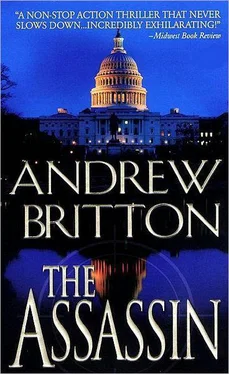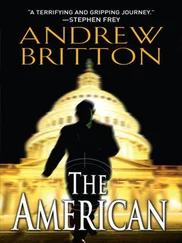Andrew Britton - The Assassin
Здесь есть возможность читать онлайн «Andrew Britton - The Assassin» весь текст электронной книги совершенно бесплатно (целиком полную версию без сокращений). В некоторых случаях можно слушать аудио, скачать через торрент в формате fb2 и присутствует краткое содержание. Жанр: Триллер, на английском языке. Описание произведения, (предисловие) а так же отзывы посетителей доступны на портале библиотеки ЛибКат.
- Название:The Assassin
- Автор:
- Жанр:
- Год:неизвестен
- ISBN:нет данных
- Рейтинг книги:3 / 5. Голосов: 1
-
Избранное:Добавить в избранное
- Отзывы:
-
Ваша оценка:
- 60
- 1
- 2
- 3
- 4
- 5
The Assassin: краткое содержание, описание и аннотация
Предлагаем к чтению аннотацию, описание, краткое содержание или предисловие (зависит от того, что написал сам автор книги «The Assassin»). Если вы не нашли необходимую информацию о книге — напишите в комментариях, мы постараемся отыскать её.
The Assassin — читать онлайн бесплатно полную книгу (весь текст) целиком
Ниже представлен текст книги, разбитый по страницам. Система сохранения места последней прочитанной страницы, позволяет с удобством читать онлайн бесплатно книгу «The Assassin», без необходимости каждый раз заново искать на чём Вы остановились. Поставьте закладку, и сможете в любой момент перейти на страницу, на которой закончили чтение.
Интервал:
Закладка:
“I’m not used to this,” she said self-consciously. It was a trivial, unavoidable shortcoming, but she was embarrassed nonetheless.
“We’re almost there,” he assured her. “Just another few minutes.”
They kept walking. The trees began to thin out a little, giving way to a flat field on the left. A small copse of pines provided some natural protection from the weather, the leaf cover less pronounced, patches of brown soil visible in places. Vanderveen stopped and looked around. Raseen had folded her arms tightly across her chest and was shivering visibly.
He dropped the pack from his shoulders and tossed it to her. She unfolded her arms in time to catch one of the straps.
“There are some gloves, a jacket, and a thermos of coffee inside,” he said. “Try to keep warm. This will take a little while.”
She nodded and opened the pack, hurriedly pulling on the nylon jacket, then the black knit gloves. Turning his attention back to the case, Vanderveen flipped the latches and began removing the components of a FAMAS G2 assault rifle.
First developed in 1967 by GIAT Industries, an unprofitable corporation owned by the French government, the FAMAS F1 was designed to replace the aging MAT-49 submachine gun, which had been in use in the military and police forces for nearly sixty years. Like its predecessor, the G2 featured a bullpup design. The magazine well was located behind the grip and trigger guard, and its design allowed for ambidextrous use. Over the years it had proved a most reliable weapon, easy to maintain and highly accurate out to 500 yards. For this reason, the FAMAS G2 was still in use with most of the French law-enforcement community, including the CRS, the general reserve of the national police. Not coincidentally, it was this last group that was tasked with the protection of Dr. Nasir Tabrizi in Paris.
The weapon that Vanderveen was putting together now, however, was slightly different from that used by the CRS in that it had been converted for use by police snipers. The barrel was 25.5 inches in length, a little more than 5 inches longer than a standard G2, and the carrying handle had been replaced by an integrated telescopic mount. The barrel modification extended the rifle’s range to about 650 yards, but also made the weapon more accurate at shorter distances.
Earlier in the day, he had used a range finder to check the distance over which he would actually be firing. It came out to 230 yards, a relatively easy shot by most standards, a walk in the park for a graduate of the U.S. Army’s Sniper School. Nevertheless, a number of factors played into that range; for one thing, Vanderveen would be shooting from the backseat of a car. That meant cramped quarters, which would lead to muscular strain and irregular breathing, both of which could throw off his aim. Second, he would be firing through glass, an iffy proposition in most cases, but especially when using a rifle chambered for anything less powerful than. 308 match-grade ammunition. If that wasn’t enough, he would only have about five seconds of confusion for cover, and it was imperative that his targets did not survive the initial engagement. There was a strong possibility that the French security officers on the scene would incapacitate at least one of the assassins, but he couldn’t count on that to transpire. So in the space of a few seconds, he would have to watch, decide, and act accordingly.
Yasmin Raseen was leaning against a moss-covered tree, watching with obvious interest as he finished putting the rifle together. He had to admit that it was an intimidating weapon, despite its rather ugly design. The standard flash suppressor had been removed, the barrel threaded externally in two places to accommodate a sound suppressor. As he turned the cylindrical can into place, Vanderveen was pleased to see that the machinist had used left-hand threads. It was rare, but meant that the suppressor would not loosen, but rather tighten with each successive shot. The two-point mount would also help ensure the suppressor’s stability.
Finally, he attached the telescopic sight, a Leupold Mark 4, which locked easily onto the standard NATO mount. Walking over to Raseen, he handed her the weapon and, unzipping the pack once more, pulled out a heavy-duty stapler and a single paper target. The bull’seye design was conventional in size and form, with a 1-inch background grid for easy elevation changes. Leaving the G2 with Raseen, he used his Leica range finder to pick a tree 25 yards away from his shooting position. Walking out, he stapled the target to the tree, the trunk of which was wide enough to accommodate the full scale of the target, then came back and retrieved his weapon.
A thin shooting mat was rolled up inside the backpack. Vanderveen pulled it out and unrolled it before placing the pack on the end. Lying down on the mat, he propped his left forearm over the pack and settled in behind the makeshift support, tucking the butt of the rifle into his right shoulder. Peering through the scope, he found the paper target immediately. After centering the crosshairs, he released the air from his lungs and squeezed the trigger.
Pierre Besson brought his tractor to a rumbling halt and stared down at the vehicle on the rutted road. He’d just finished his work for the afternoon and was looking forward to a hot meal and a leisurely nap in his converted farmhouse 2 kilometers up the road. It wasn’t much of a respite, but Besson took great pleasure in minor comforts, as befitting the humble existence of a dairy farmer in rural France. Besson had inherited the family business the previous spring, and the ensuing months had changed the way he defined work. So far he had found it to be a lonely, secluded existence, and it definitely wasn’t where he had seen his life going one year earlier. It was then that he’d completed the agricultural program at the Institute Superieur d’Agriculture in Lille. He had been leaning toward research in the months leading up to graduation, dreaming of someplace sunny, but the natural course of events had brought him back to the life he had always known.
He had to admit that it wasn’t all bad; according to his solicitor, the property was worth upwards of 1.3 million Euros. If he ever grew tired of the lifestyle, he knew he could sell it all and live out his days in idle luxury. It was a tempting proposition for the twenty-six-yearold Besson, but his name was too attached to the land for him to seriously consider that option. Despite his youth, his roots were grounded in tradition. More than 200 acres of the French countryside had been in his family for nearly seventy-five years, including this narrow lane, where the offending vehicle was parked.
Setting the brake, Besson climbed down from his tractor and walked up to the SUV. The late-model Mercedes was obviously empty, its owner nowhere in sight. The hood wasn’t up; there was nothing to indicate engine trouble. And yet, why would anyone stop here? It was a long walk to the river, so it couldn’t be fishermen. Besides, what kind of fisherman would drive a vehicle such as this? It didn’t make sense at all.
There were tracks, he suddenly noticed. Tracks in the mud, twin trails moving away from the vehicle, leading up to the fence and beyond.
Besson gazed into the woods for a moment, deciding. He didn’t really feel like walking out there, and if it was just locals, it probably wasn’t a problem. He’d made it clear that they were free to hike or even hunt on his land, assuming they had his verbal permission in the latter case. On the other hand, poaching was common in this part of the country, and it was something that Besson had been forced to deal with on several occasions. Like most serious hunters, he despised poachers. It sickened him to see the way they perverted a noble sport, and he certainly didn’t want them anywhere near his land.
Читать дальшеИнтервал:
Закладка:
Похожие книги на «The Assassin»
Представляем Вашему вниманию похожие книги на «The Assassin» списком для выбора. Мы отобрали схожую по названию и смыслу литературу в надежде предоставить читателям больше вариантов отыскать новые, интересные, ещё непрочитанные произведения.
Обсуждение, отзывы о книге «The Assassin» и просто собственные мнения читателей. Оставьте ваши комментарии, напишите, что Вы думаете о произведении, его смысле или главных героях. Укажите что конкретно понравилось, а что нет, и почему Вы так считаете.












